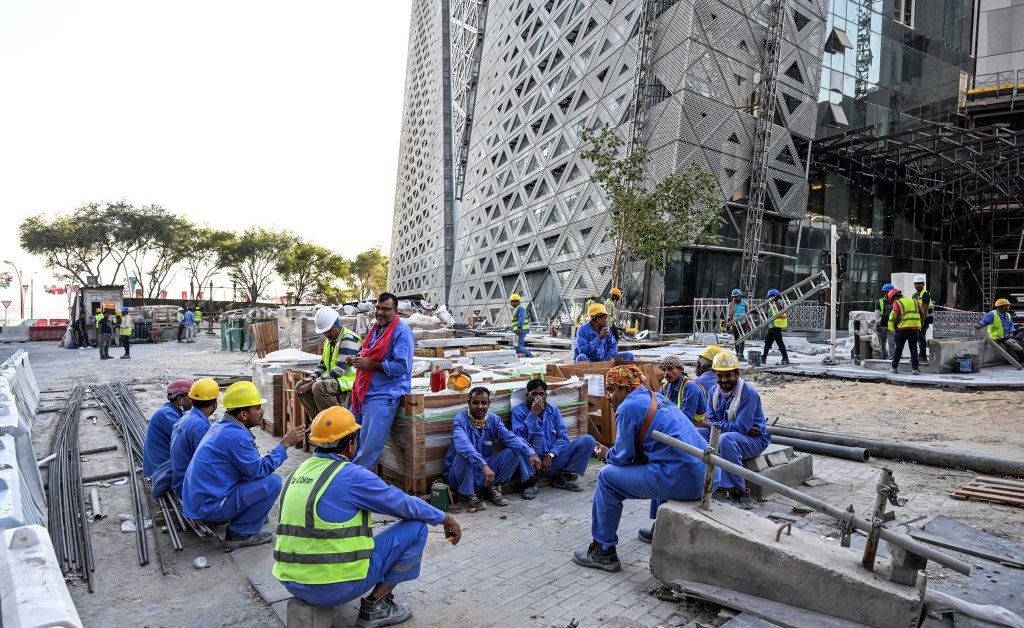Many things have changed since Jahurul Mohammed first came to Qatar eight years ago. For one, the colossal Al Bayt Stadium, which hosted the 2022 World Cup opening ceremony, didn’t exist, and the only thing other than sand dunes in its vicinity 30 miles north of Doha was a famous wedding hall. “None of this was here,” says Mohammed, a taxi driver from Bangladesh, sweeping his hand across the dazzling cityscape of concrete and neon beyond his windshield. “Even a few months ago, the road here was very rough. But they made sure it was finished in time for the World Cup.”
It’s far from the only change that Mohammed witnessed as the tournament approached. When he first arrived in Qatar, he was only allowed to obtain an exit permit with his employer’s approval. But significant labor reforms unveiled in 2017, following intense lobbying by the International Trade Union Confederation, means that Mohammed can now travel whenever he wishes. (Though due to cost, he only visits family in Bangladesh every 18 months or so.) And following the abolition of the kafala system, which gave employers almost total control over migrant workers’ work and immigration status, he says switching jobs is simplicity itself. “I just have to go to a government office, fill out a couple of forms and two or three days later my new ID arrives by post,” he says.
Since the World Cup was awarded to Qatar in 2010, human rights groups and the world’s media have closely scrutinized the tiny Gulf petrostate of 2.9 million, especially its treatment of workers brought in to build the estimated $250 billion of infrastructure needed to host the tournament. Earlier this month, Hassan al-Thawadi, secretary general of Qatar’s World Cup organizing committee, told U.K. media that “between 400 and 500” migrants had died on World Cup-related projects in the past 12 years. The estimate is drastically higher than the “three deaths” previously offered by Qatari officials, who quickly walked back al-Thawadi’s revised figure. Both figures are still dwarfed by the thousands that human rights groups such as Amnesty and Human Rights Watch estimate have died.
Read More: How Many Migrants Died Erecting the Qatar World Cup?
Only 300,000 of Qatar’s residents are citizens, with the remainder mainly economic migrants from Asia and Africa or white-collar workers from the Global North. While the fate of those toiling in the construction industry under extreme heat have garnered the most attention leading up to the World Cup, they amount for 20% of the total migrant workforce, with most employed in everything from domestic work to the service industry.
Qatar’s overhaul of its labor system has led to undeniable improvements, yet rights groups insist that spotty implementation and enforcement undermine any benefits. According to Amnesty International, thousands of workers are still facing delayed or unpaid wages, refusal of rest days, unsafe working conditions, impediments to changing jobs, and unsatisfactory avenues for addressing grievances.
“Although Qatar has made important strides on labor rights over the past five years, it’s abundantly clear that there is a great distance still to go,” says Steve Cockburn, Amnesty International’s head of economic and social justice. “Thousands of workers remain stuck in the familiar cycle of exploitation and abuse thanks to legal loopholes and inadequate enforcement.”
For those who speak up against abuses, the consequences can be dire. The family of Jordanian whistleblower Abdullah Ibhais, who raised concerns about labor conditions on World Cup projects, has accused Qatar of torture, claiming he spent four days “in complete darkness in solitary confinement after being physically assaulted.” Ibhais, a former media manager in Qatar’s World Cup committee, told U.K. media that 200 workers in Education City Stadium and Al Bayt Stadium had no drinking water and had not been paid for four months. He is currently serving a three-year sentence on fraud charges that rights groups claim are retributive. “There’s no evidence against him whatsoever,” says Nick McGeehan, a founder-director at workers rights NGO FairSquare, which has been advocating for his release.
And Qatari officialdom has brushed off criticism in an often hamfisted manner. Last week, Nasser Al Khater, chief executive of the 2022 World Cup in Doha, shrugged that “death is a natural part of life” when quizzed by reporters on the death of a Filipino worker at a hotel where the Saudi national team had stayed.
Yet dozens of candid conversations with migrant workers—both on and off-the-record—over two weeks in Qatar revealed strikingly similar sentiments. They say that Qatar is not perfect, but that it’s a clean, safe, and—other than the scorching summers, when temperatures regularly breach 50°C (122°F)—comfortable place to work. Abuses (and deaths) do happen, but migrants TIME spoke to typically reserve blame for unscrupulous employment brokers from workers’ own countries rather than Qatari officials.
“I see a lot of stories [in the Western media] about Qatar being exploitative,” says Daniel Sey, a security guard from Ghana working at a hotel near Doha’s Waqif Souq. “I don’t understand it. True, some people are ripped off but they’re [typically] the ones who try to work illegally on the side. For most people, Qatar is a safe place to work. We’re not idiots.”
At the same time, human rights groups push back at the characterization that Qatar’s main culpability is callous indifference, pointing out how indebtedness and onerous sponsorship are invaluable tools of control in a society where 90% of the population are foreign migrants. “[Worker] origin states don’t have the power to fix these things like Qatar has,” says McGeehan.
Everyone’s experience differs, of course. Qatari law outlaws the payment of recruitment fees, but a recent survey by Qatar University’s Social and Economic Survey Research Institute affiliate found that 54% of low-wage workers paid employment brokers to secure their passage to the country. Typical rates vary between $1,000 and $5,000—a debt which takes several months or years to pay off and puts workers in vulnerable situations where they are more prone to exploitation or abuse.
John, who insisted on TIME using a pseudonym for fear of getting into trouble with his employer, says he had to pay $3,000 to his broker in India’s Kerala state to travel to Qatar. He was then pressured into working construction for a third party not tied to his sponsor to pay off the debt. When the employer didn’t pay his wages, he couldn’t go to the police or seek official redress since he had effectively been working illegally. “There are hundreds of people like me,” John says.
Qatari officials say they have struck off hundreds of employment agents based in South Asia and Africa since reforms were initiated, though rights groups say more needs to be done to stamp out unscrupulous practices.
Read More: Weary and Thirsty, World Cup Fans Try to Find Joy at a Complicated Tournament
Meanwhile, Qatar enacted a new national minimum wage that applies to everyone in the country, including migrant workers. It came into force in March and has led 280,000 workers—13% of the workforce—to see their wages increase, according to the U.N.’s International Labour Organization (ILO). Employers are now also obliged to pay employees’ wages through Qatari banks, allowing the Labor Ministry to monitor the transfers and reduce wage abuses. And in 2020, the Qatari government set up a Workers’ Support and Insurance Fund that has reportedly reimbursed $320 million to victims of illegally withheld wages and related abuses. “Accessing this fund, however, remains complicated and expensive for workers,” says a report published in November by the London-based Trade Union Congress.
Some 350,000 workers have also changed jobs since the abolition of kafala, while for the first time across the Gulf region, migrant workers can elect their own representatives to management committees, helping them to raise grievances with employers. Still, trade unions remain illegal despite being permitted (with varying efficacy) in nearby Kuwait, Oman, and Bahrain.
Spectators watch the World Cup match between Brazil and Switzerland, Group G, on a big screen on the outskirts of Doha, Qatar, on November 28, 2022.
Mads Claus Rasmussen—Ritzau Scanpix/AFP via Getty Images
According to Ruba Jaradat, assistant director-general and regional director for Arab States at the ILO, reforms in Qatar have been real and impactful because they correspond with the government’s National Vision 2030 plan to modernize industry and create a more competitive knowledge-based economy. She says there are ongoing negotiations toward setting up a permanent ILO representative office in the country.
“It’s universally recognized that there’s still a lot of work to do to ensure that workers—as well as employers—can benefit from these labor reforms,” she says, pointing to how competition for the best workers means raised standards in Qatar, which trickle down across other Gulf states. “Qatar has put in place a number of laws and systems that can be replicated elsewhere across the region.”
A far more contentious matter is the deaths of migrant workers building World Cup related projects, and the lack of compensation for their families.
The Workers’ Support and Insurance Fund doesn’t cover compensation for deaths that are typically marked “natural causes,” ignoring the sad reality that the extreme heat of the workplace is commonly believed to have contributed to their passing. Today, Doha’s daily summer temperatures are 1.4°F higher on average than when the World Cup was awarded to Qatar in 2010. Research published in the Cardiology Journal in 2019 found a strong correlation between heat stress in the deaths of more than 1,300 young Nepali workers over Qatar’s summer months between 2009 and 2017. Frequently, workers are discovered dead in their dormitories—their deaths not properly investigated.
Last year, groundbreaking legislation was adopted to protect outdoor workers during the summer months. Workers cannot labor outside between 10 a.m. and 3:30 p.m. from June 1 to Sept. 15 and, regardless of the time, all work must stop if a workplace’s wet-bulb globe temperature (WBGT)—which factors in humidity, thus is a more accurate gauge of potential harm than simple thermometer readings—rises beyond 32.1°C. “This is the most advanced legislation to protect workers from heat stress in the region,” says Jaradat.
Read More: Thousands of Migrant Workers Died in Qatar’s Extreme Heat. The World Cup Forced a Reckoning
Martin Schibbye, the editor-in-chief of the crowdfunded journalism platform Blankspot, spent two years investigating the lives and deaths of migrant laborers in Qatar by traveling to home villages to speak to their families. From his research, he published “Cards of Qatar,” a package of 46 baseball-style trading cards—but containing the names and story of migrant workers who traveled to Qatar but never made it home. They were then sent to FIFA, the Qatari government, and prominent World Cup advertisers in order to raise awareness of the human toll of the tournament.
“I wanted to go beyond that statistical debate and to tell the stories of the people that worked to build Qatar during the last 10 years and that didn’t return,” he says. “To portray them as the stars that they were for trying to bring their families out of poverty.”
FIFA, which has pocketed a record $7.5 billion in revenue over the four-year period covering the Qatar World Cup, has refused to commit to a remedy fund. Instead, it has scolded soccer associations and players who have called for one, telling them to “focus on the [soccer].” This attitude is increasingly at odds with FIFA global sponsors, among whom Adidas, Coca-Cola, and McDonald’s have all called for more to be done to compensate deceased workers.
While pushing for adequate compensation, Schibbye says it is important to pay tribute to what reforms have been made, otherwise there is reduced impetus for further improvements and increased risk of backsliding. “The reforms in Qatar are unique when compared to Saudi Arabia or Kuwait or elsewhere in the region,” says Schibbye. “And that needs to be told also.”
Schibbye also says it’s important to look at Qatar in the context of a Global South that has been disproportionately squeezed by the pandemic and related economic slowdowns. Despite this, a more than tripling of overseas remittances to Nepal from $2.54 billion in 2010 to $8.75 billion in 2019 has corresponded with a reduction in the national poverty rate from 25.2% to 16.6%. Some 56% of Nepali households receive remittances, and Schibbye says even the sons of workers who died in Qatar that he encountered today dream of getting a job there.
“We need to understand poverty and how it is like a hammer on South Asia,” says Schibbye. “Otherwise, we are never going to get the whole picture.”
For the ILO’s Jaradat, the simple truth is that labor rights in Qatar—and hopefully in time for workers around the region—are better owing to the World Cup. In September, a lobby group representing workers from across the Horn of Africa called on other Gulf countries to emulate Qatar’s labor reforms. “We can definitely say that the scrutiny that accompanies the tournament has accelerated labor reforms in Qatar,” says Jaradat. “The ILO works around the world and it’s rare to see change happen at this pace.”
More Must-Reads From TIME


